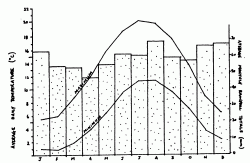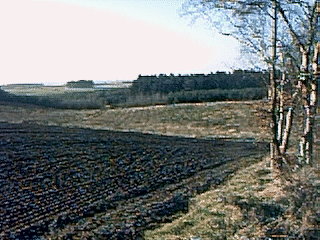The physical Geography
The relief of the area.
The highest land is located to the north (along Blidworth Waye) and east of the region. (around Forest Farm) A valley that runs from Seven-Mile House and Barracks Farmhouse westwards towards the Leen Valley dissects these hills. There is no stream in this valley at present, but the extensive deposits of alluvium and peat along its floor indicate that this has not always been so.The village of Papplewick is located on the eastern side of the valley of the R. Leen, at between 75m and 90m above sea level. The principal road, Main Street, occupies the gently sloping ground of a south-facing spur. There is rich farmland surrounding the village, and most of the parish of Papplewick is situated on gently rolling hills between 75m and 125m above sea level.
The geology and soils of the area.
The rocks of the area around Papplewick are all of the Permo-triassic period (200 to 300 million years old) and lie above the coal measures for which this part of Nottinghamshire is more famous. They are arranged in layers (or ‘beds’) which are inclined (or ‘dip’) towards the east, at angles of between 2º and 6º. The oldest rocks are found at the surface in the west of the area, and the rocks at the surface are younger towards the east. There are four main types of rock found in the area. Starting with the oldest these are:
- The Magnesian Limestone beds outcrop to the west of the R. Leen. Although these beds have been quarried in the neighbouring parish of Linby, they are covered with regolith and soil in the Papplewick area. The rock is a yellow-orange sandy limestone, which weathers to produce a lime-rich clay soil. It is this rock which has been used as a building stone in the parish.
- The Red Marl is a thin bed of mudstone that occupies belt parallel to the Leen valley. The soils developed on this are lime-rich clay-loams, but poorly drained
- Above the Red Marl is a thin bed of Mottled Sandstone. This is virtually indistinguishable from, and merges into –
- The Pebble Sandstone beds form the surface over the highest parts of the area. In the parish it is a soft red sandstone which contains pebbles as big as 5cm across. The rock is porous (and is used as an aquifer at the nearby Papplewick pumping station) and weathers to a sandy, well-drained soil. In summer this soil can be so dry as to require irrigation when some crops are grown
In addition to the solid rocks there are also three important surface deposits.
- Glacial sand and gravel. Between Papplewick Hall and The Lodge is a low rounded hill, formed of fluvio-glacial till (sand and gravel) material deposited by the Pleistocene ice-sheets.
- Alluvium. In the lowest parts of the Leen valley are deposits of river mud and sands. Being low lying, the land covered by this deposit is poorly drained and liable to flood. Alluvial mud also formed the floors of the reservoirs for the mills that were once built along the valley.
- Alluvium with gravel and peat. These deposits, (which were probably laid down on the bed of a meltwater lake when the Pleistocene ice sheets melted) are found in the valley between Seven-Mile House and the R. Leen, and in the secondary valley running south from Barracks Farm. The soils developed on peat are still badly drained. The rounded pebbles from this deposit litter the fields along the valley floor.
- The silty soils on Papplewick Moor are ideal for arable farming. They get very dry in summer and other periods of dry weather. The low relief of this area is obvious from the picture.
3. The climate of the Papplewick area
 The climate statistics for the average temperatures and rainfall recorded at Watnall weather station are shown on the graph. Watnall is only 6km southwest of Papplewick, so we can assume that the average climate in the area around Papplewick is much the same. In detail, however, the microclimate may be different. Exposure to winds, drifting snow and the incidence of ground frost, for example, will all vary across the parish.
The climate statistics for the average temperatures and rainfall recorded at Watnall weather station are shown on the graph. Watnall is only 6km southwest of Papplewick, so we can assume that the average climate in the area around Papplewick is much the same. In detail, however, the microclimate may be different. Exposure to winds, drifting snow and the incidence of ground frost, for example, will all vary across the parish.



